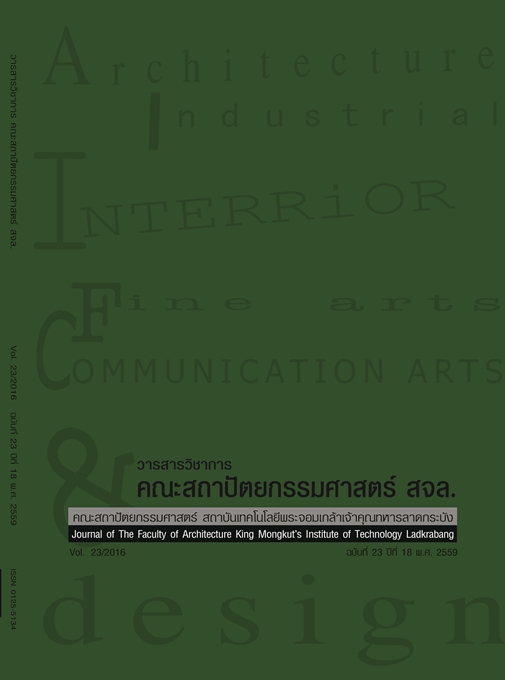แนวทางการพัฒนาที่อยู่อาศัยสีเขียวชุมชนคลองหนึ่งพัฒนา (The Development Guidelines for Green Housing of Klong Nueng Pattana Community)
Main Article Content
Abstract
บทคัดย่อ
การศึกษาแนวทางการพัฒนาที่อยู่อาศัยสีเขียวของชุมชนคลองหนึ่งพัฒนา มีเป้าหมายเพื่อพัฒนารูปแบบที่อยู่อาศัยของชุมชนผู้มีรายได้น้อยที่คำนึงถึงผลกระทบต่อสิ่งแวดล้อมจำนวน 71 หลังคาเรือน การศึกษานี้รวบรวมเอกสารสัมภาษณ์หน่วยงานที่เกี่ยวข้อง และการวิจัยเชิงปฏิบัติการ (Action Research) นำมาใช้โดยการทำงานร่วมกับชุมชน สหพันธ์พัฒนาองค์กรชุมชนคนจนเมืองแห่งชาติเทศบาลนครรังสิตและคนในชุมชน ทั้งหมดนี้เข้ามามีส่วนร่วมทั้งกระบวนการวิจัยและออกแบบโดยเฉพาะอย่างยิ่งผู้พักอาศัยที่เข้าร่วมออกแบบบ้านด้วยตนเอง พฤติกรรมและความต้องการด้านประโยชน์ใช้สอยภายในบ้านพักอาศัยของชุมชนถูกวิเคราะห์ด้วยสถิติเชิงพรรณนา ผลวิเคราะห์ด้านความสามารถและความสัมพันธ์ระหว่างตัวแปร
ต่างๆ ในเกณฑ์ที่อยู่อาศัยสีเขียว และเกณฑ์ประเมินอาคารประหยัดพลังงานและเป็นมิตรต่อสิ่งแวดล้อมสำหรับบ้านพักอาศัยกับตัวแปรอื่นๆ ก็ถูกอธิบายด้วยสถิติพรรณนาที่มีข้อมูลจากโปรแกรมสำเร็จรูปทางสถิติ SPSS ผลจากการวิเคราะห์ดังกล่าวได้ถูกนำเสนอสรุปในที่ประชุมกลุ่มชุมชนกลุ่มผู้มีส่วนได้ส่วนเสียทั้งภาครัฐและประชาชน โดยการออกแบบตัวอย่างสำหรับชุมชนถูกทำในขั้นต่อไป
ชุมชนนี้มีการตั้งถิ่นฐานตั้งแต่ราวปี พ.ศ. 2500 ชาวบ้านส่วนใหญ่ล่องเรือจากจังหวัดอ่างทอง ราชบุรี และสิงห์บุรีนำถ่านและเครื่องใช้ดินเผามาขายที่ตลาดรังสิต โดยตั้งโรงเผาถ่านในซอยจึงมีชื่อ “ซอยโรงถ่าน” ซึ่งปัจจุบันเปลี่ยนเป็นซอยรังสิตนครนายกหนึ่ง และมีการอพยพเข้ามาตั้งถิ่นฐานเพิ่มขึ้นอย่างรวดเร็วในราวปี พ.ศ. 2530 เพื่อมาหาแหล่งงานใหม่โดยปัญหาหลัก คือน้ำท่วมซอยในช่วงฤดูฝนทุกปี และน้ำในคลองหนึ่งมีสภาพเน่าเสียไม่สามารถอุปโภคได้ ในการนี้ชุมชนซึ่งรุกล้ำคลองชลประทานดังกล่าว จึงถูกเสนอย้ายที่อยู่เพื่อไปสร้างชุมชนในที่ดินแห่งใหม่ (Relocation) สำหรับด้านความต้องการ
พื้นที่ใช้สอยในอาคารพบว่า มีความต้องการผังพื้นที่ที่สามารถยืดหยุ่นปรับเปลี่ยนการใช้งานได้ โดยเฉพาะอย่างยิ่งพื้นที่สำหรับทำอาชีพในครัวเรือน สำหรับประเด็นการปฏิบัติเพื่อสภาพแวดล้อมสีเขียวของชุมชนพบว่า ชุมชนประเมินเรื่องการใช้พลังงานไฟฟ้าเท่าที่จำเป็นเป็นเรื่องที่สามารถปฏิบัติได้มากที่สุด รองลงมาคือการใช้หลอดประหยัดไฟ การไม่ใช้เครื่องปรับอากาศทำความเย็น และการคัดแยกขยะ ส่วนเรื่องที่ทำได้ยากที่สุดคือ การจับจองที่ดินที่ใกล้ระบบขนส่งมวลชนและแหล่งบริการชุมชนและที่ดินที่มีความสมบูรณ์ทางธรรมชาติ ตามลำดับ ยิ่งกว่านั้นความสัมพันธ์ตัวแปรด้านพื้นที่ใช้งานกับตัวแปรด้านทัศนคติในการรักษาสภาพแวดล้อมพบว่าหากบ้านพักอาศัยถูกออกแบบให้มีระเบียง โอกาสที่บ้านนั้นจะมีพื้นที่สีเขียว และการเปิดช่องเพื่อระบายอากาศจะมีมากขึ้น
การประชุมร่วมของชุมชนผู้อาศัยตกลงถึงเกณฑ์การพัฒนาชุมชนสีเขียว ซึ่งสามารถสรุปได้เป็น 5 ประเด็น คือ 1. การใช้ประโยชน์บริการสาธารณะ 2. การรักษาความสะอาด 3. การรักษาความปลอดภัย 4. การเลี้ยงสัตว์และ 5. เกณฑ์ การอยู่ร่วมกันเพื่อเป็นพื้นที่พัฒนาสภาพแวดล้อมสีเขียว สำหรับรูปแบบบ้านพักอาศัยสีเขียวโดยชุมชนมีส่วนร่วมออกแบบ บ้านของตัวเอง และสามารถสรุปได้เป็น 9 รูปแบบ คือ บ้านเดี่ยว 2 ชั้น 3 แบบ บ้านแฝด 2 ชั้น 2 แบบบ้านเดี่ยว 2 ชั้น ขนาดเล็ก 1 แบบ และบ้านแถว 2 ชั้น 3 แบบแยกตามขนาดของพื้นที่ดิน 15 ตร.วา 12 ตร.วา และ 10 ตร.วา ตามลำดับ
นอกจากนั้นแล้วองค์ประกอบตามเกณฑ์ที่อยู่อาศัยสีเขียว 8 หมวด ที่ชุมชนประเมินว่าทำได้ดังนี้คือ 1. หมวดสถานที่ตั้งบนราคาที่ดินประเมินไม่เกิน 15,000 บาท/ตร.วา 2. หมวดผังบริเวณและภูมิสถาปัตย์คือการใช้บล็อคหญ้าและร่มเงาพืชพันธุ์ให้กับพื้นดาดแข็ง 3. หมวดเปลือกอาคารใช้ฉนวนใต้หลังคาและผนังสีโทนอ่อน 4. หมวดระบบปรับอากาศไม่จำเป็นต้องใช้ 5. หมวดระบบธรรมชาติและพลังงานทดแทนสามารถใช้ไฟฟ้าเท่าที่จำเป็น 6. หมวดการระบายอากาศจากการเปิดช่องหน้าต่างและพื้นที่สูบบุหรี่นอกบ้าน 7. ระบบสุขาภิบาลโดยประหยัดน้ำ กักเก็บดีและสุขภัณฑ์ประหยัดน้ำ 8. หมวดวัสดุและการก่อสร้างสามารถคัดแยกขยะ ใช้สีและสารเคลือบผิวไม่กระทบสิ่งแวดล้อม และจากการประชุมสรุปความเห็นว่า
ควรเพิ่มการสนับสนุนการใช้แผง Solar Cell /Solar Roof ในครัวเรือนให้เป็นทางเลือกเพิ่มเติม
คำสำคัญ: ที่อยู่อาศัยผู้มีรายได้น้อย ที่อยู่อาศัยสีเขียว การพัฒนาชุมชนอย่างมีส่วนร่วม บ้านมั่นคง
Abstract
The study of the guidelines for green housing development aimed to develop the housing for 71 low-income households in the Klong Nueng Pattana community by concerning green environmental impacts. This study
collected data from documents and interview with the related organizations. The action research was also conducted by working closely with the National Urban Poor Community Federation, the Rangsit Municipality and people in the community. They participated in research and design process.Especially, the residents designed their own house. Living behavior and functional requirements were analyzed by using descriptive
statistics. Result from ability and relationship between various variables of green housing criteria, energy saving buildings criteria and eco-friendly evaluation criteria were also analyzed through descriptive statistics from SPSS program. The findings were presented to the community, public and private stakeholders in the community meeting and then the housing prototype was design as the guideline.
The community was settled since 1957. Most residents moved from Ang Thong, Ratchaburi and Singburi Provinces by boat to sell coal and pottery at Rangsit Market. They set up the charcoal factory which led to the informal name “Soi Rong Tan” and recently it is changed to be Soi Rangsit – Nakorn Nayok 1. In 1987, increasing numbers of people quickly moved in. They searched for new jobs. Seasonal floods in the rainy season are the main trouble and the water in the canal is not drinkable and useable because of its smell. Apart from these, many houses were built on the public canal bank. With all these reasons, community relocation is proposed. In the research finding, multi-purposes area which can flexible for many functions especially for home based business is needed. In the aspect of green practice, electricity using as necessary, using of energy saving light bulb, uninstalling air conditioning and garbage sorting can be easily practice respectively. While owning the land near the public transportation, community service center and on the natural fertility area are difficult to achieve respectively. Moreover, the relationship between space usage variable and environmental conservation attitude variable presented that the houses design with terrace increases a chance
to have more green area and better ventilation.
In the community meetings, they agreed in 5 criteria for being the green developing community which
are 1) public service utilization, 2) cleanliness, 3) security, 4) animal husbandry and 5) living together criteria
for being the green environment.
For the green housing that the community’s residents participated in the design process, can be concluded to 9 types: 3 types of two-floor detached house, 2 types of two-floor semi-detached house, 1 type
of small two-floor detached house, and 3 types of two-floor shop house. All types of houses were separated by the size of land which is 15 square meters and 10 square meters. Furthermore, the community’s members
evaluated that they can follow 8 criteria of green housing, which are 1) they can afford the cost of land which do not exceed 15,000 Baht per square meters, 2) using the turf stone and plant shading for the hardscape
and layout, 3) installing the insulation under the rooftop and painting the building envelope with the soft tone color for building envelope, 4) unnecessary using air conditioning system necessary, 5) using the electricity as much as necessary, 6) opening windows for ventilation and locating the smoking area outside, 7) installing water saving sanitary wares and stored clean water and 8) sorting garbage and painting color which do not affected to environment. Moreover, according to the meetings, the solar panel and roof was introduced to attach in household for the additional choice.
Keywords: Low-Income Housing Green Housing User Participation
Community Development BaanMun-Kong Housing Project
Article Details
This work is licensed under a Creative Commons Attribution-NonCommercial-ShareAlike 4.0 International License.
Copyright Transfer Statement
The copyright of this article is transferred to Journal of The Faculty of Architecture King Mongkut's Institute of Technology Ladkrabang with effect if and when the article is accepted for publication. The copyright transfer covers the exclusive right to reproduce and distribute the article, including reprints, translations, photographic reproductions, electronic form (offline, online) or any other reproductions of similar nature.
The author warrants that this contribution is original and that he/she has full power to make this grant. The author signs for and accepts responsibility for releasing this material on behalf of any and all co-authors.


